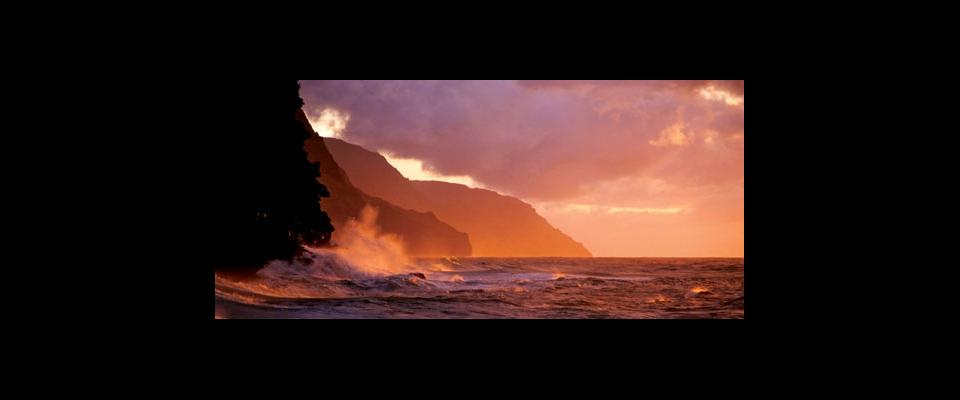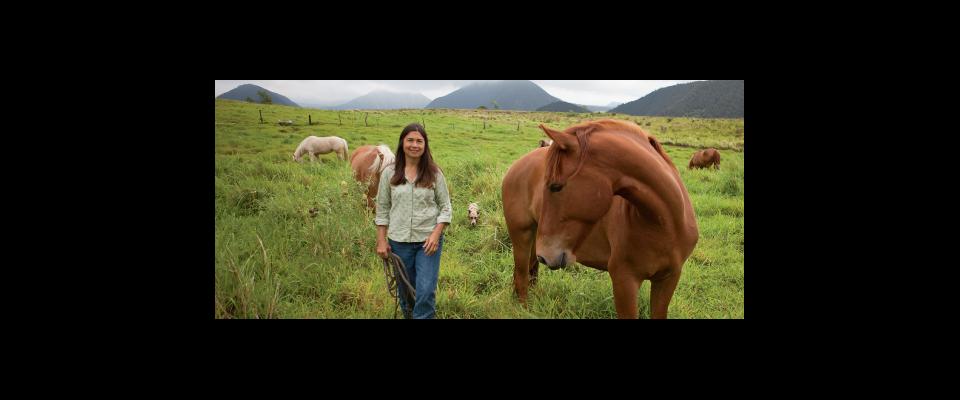When you grow up on a tropical island, you get used to being host to others’ escapist fantasies. Hawaii has long lost her allure as uncharted territory—most of her secrets have been exposed, hidden valleys explored, proud cultural heritage packaged, priced, and sold. This is the blessing, and curse, of beauty: Strangers love you and want to know you intimately; if you’re Hawaii, that means 7.5 million strangers every year.
When others come to your paradise to find solitude, where do you find yours? This longing has taken me from my hometown on Oahu into the jungles of Central America and to islands in Southeast Asia. A few years ago, I finally found what I was looking for—a mere island hop from where I started. The place was Kauai’s Na Pali Coast.
My first trip was four years ago. I’d found it by way of the Kalalau Trail: a grueling, 11-mile trek along rocky ledges best traversed by wild goats. Two summers ago my friends and I decided to return by kayak. The upside: not carrying a heavy pack filled with food, clothes, and camping supplies. The downside: By sea, the trip can be a peaceful float or a wrestle against the elements, all depending on the whims of nature.
We’d planned a four-day kayak and camping trip along the Na Pali Coast—a 17-mile ocean voyage past wild, uninhabited valleys, sea caves, and the most remote beaches in the Hawaiian Islands. Because the long stretch of coast is mostly lava rock cliffs, for more than ten miles there is no easy place to stop. The one-way sweep of the current means there’s no way to turn back.
Our destination was a valley named Kalalau, which means “wanderer.” Because it is accessible only by a narrow, rocky trail and by sea, Kalalau resembles a primeval Eden. There is no plumbing, no running water (except streams), and no electricity. If you get hurt, you pray for a passing tour boat or helicopter, or send for help by foot or kayak, which could take a whole day. The valley is verdant with guavas, mangos, oranges, bananas, and taro.
After launching from the north shore’s Haena Beach, we rounded the reef, then skirted the base of the steep cliffs. The ocean was frisky that day, and waves crashed against the rocks, showering us with sea spray and foam. We passed a few sea caves, dark gaping holes in the lava where waves gushed in and out. I could see valleys tucked a hundred feet above the cliffs—buzzing with wet, green wilderness. I remembered edging along the narrow, cliffside trails, a heavy backpack weighing me down. Paddling along in my kayak, I was free as a fish. The rhythm of the waves slapping against the boat and our paddles dipping simultaneously into the water soon began to lull me into a daze.
After 2-1/2 hours of paddling, I spotted the golden stretch of Kalalau Beach ahead.
Kalalau has the kind of energy that makes you shiver. Along with Nualolo Kai, a valley farther down the coast, archaeologists believe Kalalau was one of the last inhabited Native Hawaiian subsistence- based settlements in the Islands. In 1893, the same year the Hawaiian monarchy was overthrown by the U.S. military, it became the site of a tragic love story. Koolau, a local cowboy, and his wife Piilani, fled to Kalalau with their young son after Koolau contracted leprosy. At that time, the disease was widespread in the Islands, and those showing signs of it were taken from their families and quarantined in a leper colony on Molokai. To stay together, the couple hid out for four years in the wilds of Kalalau. When her husband and son died from the disease, Piilani emerged from the valley, heartbroken. The last Native Hawaiian family to live in Kalalau left for the west side of Kauai in 1919. Today, the entire Na Pali Coast is a state park.
We set up camp in a shady spot beneath the milo trees, then wandered down to the west end of the beach to the “public shower”—a 20-foot waterfall that spills from a rocky shelf into a small pool. We filled our bottles in the waterfall and treated the water with iodine tablets.
On our way back, I turned a corner on the trail and found myself face-to-chest with a large, tan, bald man sporting a frizzy gray beard and nothing else. We stepped aside and he sauntered barefoot down the trail with the kind of regal air that told us he’d been in Kalalau for quite some time. Another group of campers later informed us we had indeed brushed up against royalty. The man’s name was Ron—he was known as the “Mayor of Kalalau”—and he’d been living in the valley for about 20 years.
Although Kalalau Valley officially is uninhabited, I’d heard about a diehard crew of valley dwellers who live there illegally for months or years at a time. State park rangers sweep through every few months to clear them out, but the valley offers numerous hiding places.
We decided to explore the valley that same afternoon and set out on a web of trails that lead to waterfalls, swimming holes, and some of the largest mango trees I’ve ever seen. About ten minutes into the hike, one of my rubber flip-flops broke, so I took on the rest of the hike barefoot. Being a local girl, I felt this gave me even more insider status.
That night we built a fire from the dried, tangled branches of the milo trees that shaded our camp. It was balmy and after dinner the six of us walked down to the beach to take in the canopy of stars. We were exhausted. From our position on the island, the horizon seemed to go on forever—3,000 miles of ocean stretched between us and the northeast tip of Russia. Heavy surf pounded the shore with bone-shaking force. We lay down on the sand and succumbed to the elements.
Kalalau was nearly empty when we arrived. But as the weekend approached, more campers began to trickle in—trudging down the beach laden with heavy packs, or paddling up with the same wide-eyed expressions we’d had days before. With every new arrival, our precious paradise was polluted. It’s funny when you think about it: Three days in and we were already staking our claim of entitlement? Was this how the valley hippies felt about us? On the other hand—forget the hippies, imagine how the Hawaiians felt.
But, liberal guilt aside, Kalalau was getting crowded. We decided to break camp and spend our last night at Milolii, an even more remote valley farther down the coast.
The day of our departure, the ocean was rippled but much calmer than when we arrived. We paddled past Honopu Beach, with its vertical cliffs and magnificent arch. Down the coast, we entered another sea cave that ended in an enormous, open-ceilinged cavern, a collapsed lava tube. The coast turned gradually southwest as we passed a smaller valley called Nualolo Kai. Then the narrow, rocky beach of Milolii came into view.
Milolii was once a state campsite, like Kalalau, but was later closed because the state couldn’t maintain it for groups. It’s much more modest than Kalalau, like a less glamorous, forgotten sister. But it was empty, an abandoned picnic shelter the only sign of its former use.
We set up camp and watched the sunset—straining our eyes to catch that elusive “green flash” just as the last sliver slipped below the horizon. We settled around the fire in the encroaching darkness. Milolii was quiet. There were no drum circles, no Frisbee-throwing hippies, no stray kittens meowing for scraps. Finally, solitude. As the moon rose, we sat in silence and watched the flames devour the few pieces of dry wood we had gathered. It occurred to me that while solitude is peaceful, it can also be lonely.
Just as we dug into the bottom of our food supply—dinner plans consisted of ramen and Tang—we heard a low sputtering that grew louder every second. A crew of local fishermen pulled up in a motorboat on the far end of the beach and began unloading their gear.
When locals go camping, they go for broke. All this bare-bones, living-off-the-land, roughing-it business is for hippies and Mainlanders. These guys had a full kitchen set, ukuleles, lawn chairs, the works. Emerging from darkness, a portly middle- aged Asian man wearing a faded T-shirt and surf trunks stepped into our circle of tents.
“We got a big pot of chili over here if you guys like some,” he said. We looked at each other, then at our packages of ramen, then back at the fisherman.
When we arrived at the fishermen’s camp, the party had already started. The big guy told us they all lived on the west side of Kauai. He dished us up some chili and picked up his ukulele, joining in a loud, drunken version of “Proud Mary.” A small man who introduced himself as “Bags” tapped out beats on two upside-down cooking pots. Another guy had strung a piece of rope beside the wall of the picnic shelter, which became a makeshift bass. The youngest, clearly somebody’s son, was clanging two empty beer cans together. Bags handed me a pair of metal spoons and I did my best to chime in.
Looking around at the smiling faces, I was struck by memories from my childhood—memories of a Hawaii that was a little more innocent. A little more pure. It’s a Hawaii that’s hard to find these days, beneath all the pretty plastic wrapping and gloss. I wondered if maybe it wasn’t isolation I was seeking all this time. Maybe it was this: a sense of belonging, of being home.





















